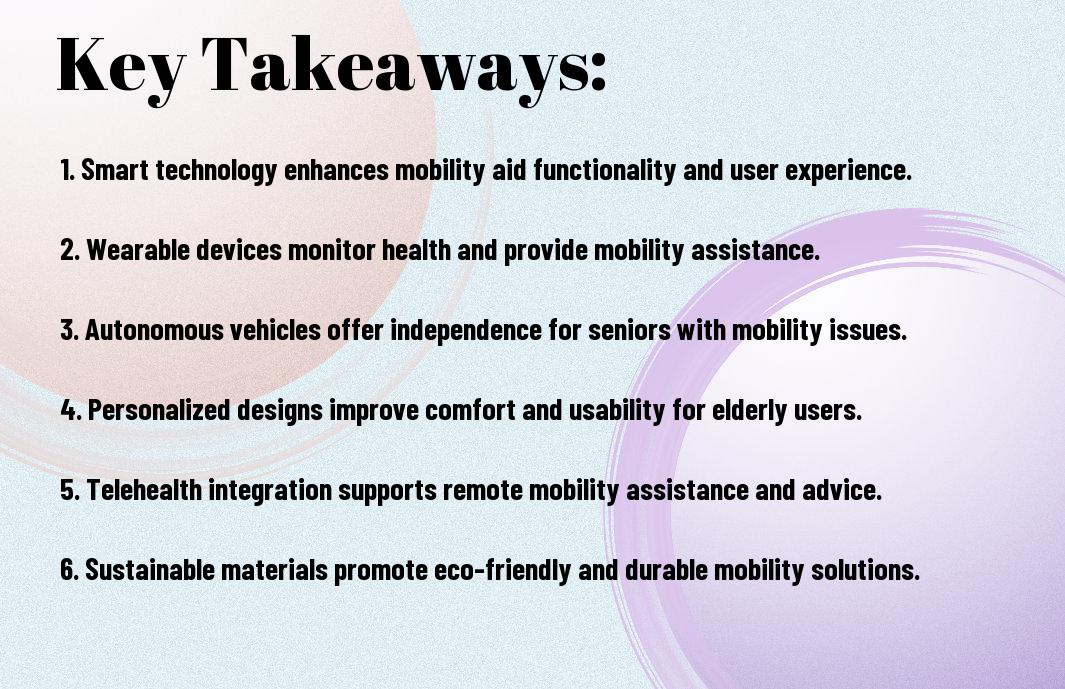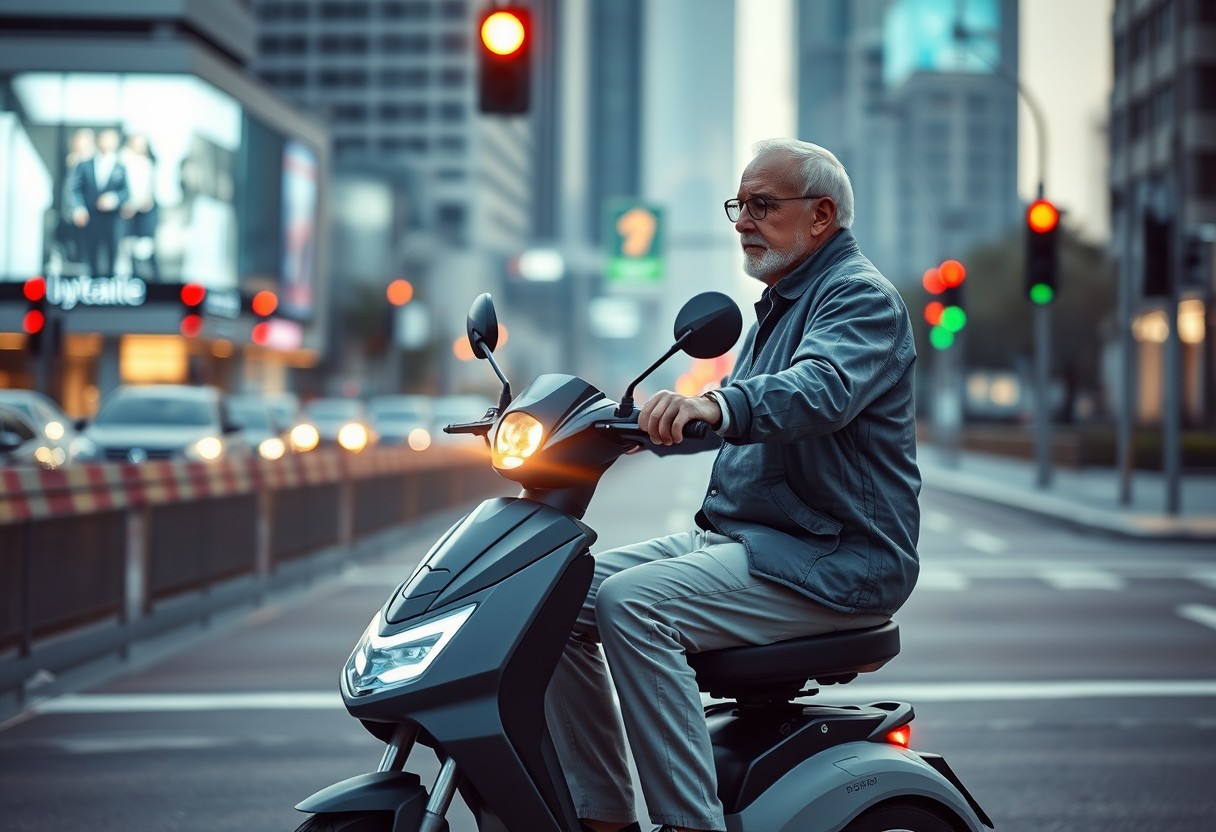Many seniors face challenges related to mobility, making it crucial to explore innovative solutions that enhance their independence and quality of life. As technology advances, he, she, and they will benefit from smart mobility aids that combine safety features with user-friendly designs. From intelligent walkers equipped with sensors to app-connected devices, these modern tools not only assist with mobility but also promote social interaction and a sense of community. Understanding these advancements will empower seniors to navigate their environments with confidence and dignity.

Key Takeaways:
- Integration of Technology: The future of mobility aids emphasizes the incorporation of advanced technologies like AI, smart sensors, and automation to enhance user experience and safety.
- Personalization: Innovative solutions are increasingly focusing on customizing mobility aids to meet individual needs and preferences, ensuring better accessibility and comfort for seniors.
- Community and Connectivity: New mobility aids aim to foster social connections and community engagement, with features that encourage seniors to interact with their surroundings and stay connected with loved ones.

Understanding the Needs of Seniors
A comprehensive understanding of seniors’ needs is crucial for developing effective mobility aids. As they age, individuals often experience a decline in strength, balance, and stamina. Innovations must address these challenges to ensure safety and independence. Moreover, there is a growing recognition of the demand for assistive devices that cater to this demographic, as highlighted in The Growing Market for Elderly and Disabled Assistive ….
Common Mobility Challenges
Common mobility challenges faced by seniors include difficulty in walking, maintaining balance, and navigating various terrains. These challenges can lead to a higher risk of falls, resulting in serious injuries and a decreased sense of independence.
Importance of Accessibility
The importance of accessibility cannot be overstated in the context of mobility aids for seniors. He, she, or they must have easy access to their living environments and community spaces to maintain an active and engaged lifestyle.
Accessibility is important for seniors as it ensures that they can safely navigate their surroundings without compromising their well-being. A lack of accessibility can lead to feelings of isolation and frustration. Consequently, investing in assistive technology and infrastructure improvements significantly enhances their quality of life. By focusing on functional designs that prioritize ease of use and safety, seniors can enjoy greater independence, confidence, and overall well-being.
Cutting-Edge Mobility Technologies
One of the most exciting developments in mobility aids for seniors is the advent of cutting-edge technologies that enhance independence and safety. From AI-driven navigation systems to advanced sensor technology, these innovations can significantly improve the quality of life for the elderly. For a deeper insight into these advancements, one can explore the article Empowering the Elderly: The Future of Medical Mobility ….
Smart Walkers and Rollators
Smart walkers and rollators are revolutionizing how seniors maintain their mobility. These devices are equipped with sensors that detect obstacles and provide alerts, ensuring safety during use. Additionally, features like GPS and fall detection make them indispensable tools for elders looking to enhance their independence while reducing the risk of injury.
Electric Wheelchairs and Scooters
Smart electric wheelchairs and scooters provide unparalleled convenience and freedom for seniors with mobility challenges. These devices often include intuitive controls, customizable seating, and advanced battery life, making them suitable for various lifestyles. They allow individuals to navigate through urban settings or enjoy outdoor activities with ease and comfort.
This technology is designed with safety in mind, featuring anti-tip systems to prevent falls, advanced braking systems for quick stops, and intelligent navigation aids that help avoid obstacles. Electric wheelchairs and scooters allow seniors to maintain their independence, ensuring they can travel without constant assistance. However, it is crucial for users to be aware of battery maintenance and following local regulations regarding usage to enhance both safety and functionality.
Wearable Mobility Aids
For seniors seeking increased independence, wearable mobility aids are becoming an important part of their daily lives. These innovative devices, ranging from smart clothing to enhanced assistive devices, help individuals navigate their environment more safely and with greater ease. By integrating technology seamlessly into everyday garments and tools, they offer users the support they need while promoting dignity and autonomy in movement.
Exoskeletons for Enhanced Movement
Enhanced mobility is made possible with the development of exoskeletons designed specifically for seniors. These wearable robotic devices assist with walking and standing, improving strength and leg function. By providing proportional support and reducing strain, exoskeletons enable individuals to regain their independence, facilitating more active lifestyles and boosting confidence in mobility.
GPS and Navigation Devices
For seniors, GPS and navigation devices serve as critical tools for maintaining independence while exploring their surroundings. These technologies offer real-time directions and updates, ensuring users can confidently reach their destinations and find their way home safely.
Movement around unfamiliar environments can be daunting for seniors, making GPS and navigation devices a game changer. These devices not only provide step-by-step directions but also feature built-in emergency alerts for added safety. In cases of disorientation, they allow individuals to quickly access help or find their way back home. With features tailored to their needs, such as voice-assisted navigation and large displays, these devices ensure seniors can venture out with confidence, reducing the likelihood of becoming lost or stranded.
Home Modifications for Improved Mobility
Now, creating a safe and accessible living space can significantly enhance a senior’s quality of life. By implementing thoughtful home modifications, they can minimize hazards and maximize mobility, allowing for greater independence and ease of movement throughout their homes. These modifications not only provide physical support but also offer emotional comfort, reducing anxiety about potential falls or limitations.
Ramps and Lifts
On many occasions, seniors face challenges navigating steps, making ramps and lifts crucial additions to their homes. By installing these features, they can bypass physical barriers, granting them seamless access to their property and eliminating the risk of potential falls. Ramps and lifts create a user-friendly environment that promotes independence.
Smart Home Integration
On the cutting edge of home modifications, smart home integration offers innovative solutions for enhancing mobility. By incorporating technology, they can control various home functions, such as lighting, thermostats, and security systems, through voice commands or mobile devices, making daily tasks more manageable and safe.
A smart home system includes features like voice-activated lights, automated doors, and monitoring sensors that not only provide convenience but also significantly enhance safety for seniors. These innovations aim to reduce dependency on others while ensuring that they have immediate assistance if needed. Importantly, with the integration of technology, they can respond promptly to emergencies. Studies have indicated that engaging smart home systems decreases anxiety and enhances the overall well-being of seniors, promoting a sense of control and security within their living environment.
Community Resources and Support
Your access to community resources can significantly enhance the mobility experience for seniors. Various organizations offer support services, educational programs, and financial assistance aimed at improving the quality of life for elderly individuals. Connecting with local non-profits, health care providers, and senior centers can open doors to various mobility aid solutions, ensuring they lead more independent lives.
Local Mobility Aid Programs
Local mobility aid programs provide vital resources to seniors who require assistance in their daily lives. These programs often include training on the use of devices, funding for mobility aids, and access to transportation services, all designed to enhance their mobility and independence.
Online Communities and Forums
Communities of seniors and caregivers are increasingly utilizing online forums to share experiences and seek advice regarding mobility aids. These platforms foster a supportive atmosphere where they can discuss challenges, recommend products, and exchange tips on mobility strategies.
Another advantage of online communities is the immediate access they provide to a wealth of shared knowledge and experiences. These platforms are invaluable for obtaining recommendations on mobility aids, learning about ongoing advancements, and finding emotional support during tough times. They also help seniors stay informed about new technologies, enabling them to advocate for the best solutions tailored to their unique needs. Ultimately, these online spaces empower them and improve their overall quality of life.
Future Trends in Mobility Aid Development
Despite the advances in technology, the journey towards more efficient and accessible mobility aids for seniors is ongoing. Emerging trends indicate a shift towards more personalized solutions, integrating user feedback and preferences into design processes. The focus is increasingly on creating devices that not only enhance mobility but also promote independence and connectivity for seniors, allowing them to lead fulfilling lives.
Advancements in Robotics
Trends in robotics are shaping the future of mobility aids with innovative designs featuring automated and assistive technologies. These advancements aim to provide seniors with enhanced mobility through intelligent systems that adapt to individual users’ needs. As robotics become more sophisticated, they promise to deliver increased safety, functionality, and improved user experience.
The Role of AI in Mobility Solutions
With the integration of artificial intelligence, mobility aids are becoming smarter and more intuitive. AI technologies enable devices to learn from user behavior, predict needs, and offer tailored assistance. This personalization enhances the experience, allowing seniors to navigate their surroundings more confidently.
Plus, AI has the potential to significantly reduce accidents by providing real-time feedback and alerts, enabling seniors to stay aware of their surroundings. These systems can analyze environmental factors, such as obstacles or changes in terrain, offering crucial information at the right moment. As a result, they empower seniors to make informed decisions about their movements, thus enhancing their overall safety. Furthermore, by integrating social features, AI can help maintain connections with loved ones, further enriching the lives of seniors using mobility aids.
Conclusion
As a reminder, the future of mobility aids holds promising innovations that significantly enhance the independence and quality of life for seniors. With advancements in technology, they are witnessing the emergence of solutions such as smart walkers, adaptive vehicles, and user-friendly mobility devices that cater to their unique needs. By embracing these innovative options, she can navigate her environment with greater ease, while he can enjoy a renewed sense of autonomy. The commitment to improving mobility aids demonstrates a collective effort to empower seniors and ensure they thrive in an increasingly accessible world.
FAQ
Q: What are some innovative mobility aids being developed for seniors?
A: The future of mobility aids for seniors includes a variety of innovative solutions such as smart wheelchairs that can autonomously navigate spaces, exoskeletons designed to assist in walking and rehabilitation, and advanced personal mobility devices like electric scooters that are easier to operate and feature improved safety mechanisms. Additionally, there are smart canes equipped with sensors that detect obstacles and provide navigation assistance, as well as telehealth equipped devices that keep seniors connected to healthcare professionals for immediate advice and support.
Q: How can technology improve the safety of mobility aids for seniors?
A: Technology can significantly enhance the safety of mobility aids for seniors through the integration of features like collision detection systems, automatic braking, stable support structures, and durable materials that withstand wear and tear. For instance, many smart wheelchairs and scooters now come equipped with anti-tip mechanisms and adjustable settings to accommodate different levels of mobility. Furthermore, GPS and geofencing can help keep seniors within safe boundaries and alert caregivers in case of emergencies or falls.
Q: What is the importance of user feedback in the development of new mobility aids for seniors?
A: User feedback plays a crucial role in the development of mobility aids, as it helps designers understand the actual needs and challenges faced by seniors in their daily lives. Engaging with seniors allows manufacturers to gather insights on usability, comfort, and design preferences, which leads to the creation of more effective and accessible mobility solutions. Incorporating feedback ensures that innovations are practical and meet the expectations of the elderly population, ultimately enhancing their independence and quality of life.

